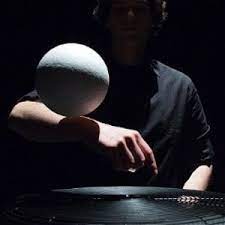Living in a material world: not-so-inanimate objects are the stars of many Edinburgh Fringe 2022 shows – as witnessed by Dorothy Max Prior in Materia, Megalith, Every Word Was Once an Animal, The Smile off Your Face, Closing Party, and A Very Old Man With Enormous Wings
We are in the Old Lab at Summerhall at 10.15am. Somehow, this feels completely appropriate, for what we are about to witness turns out to be as much a demonstration of practical physics and engineering skills as an art show – although all is done with the utmost artfulness. A calm and serious looking young man kneels onstage, leaning over an electric fan which has been placed on its side. He is feeding polystyrene balls into the wind current created by the fan and they move around in a circle, jostle each other, and eventually (for some, anyway) get edged out and on to the floor. He steps away, and over to a sheet of polystyrene, which is stacked between two fans which counterbalance each other and keep it upright. This is just the start. Later, there are all sorts of complicated games involving carved or shredded polystyrene, multiple electric fans, and a monochrome lighting plan that plays with the extremities of light and dark, as shadows are cast and strobes highlight the mechanised action.
This is Materia, a show by Andrea Salustri produced by the legendary Aurora Nova. It is described as ‘a choreography for several polystyrene shapes and one human’ – which is a pretty accurate summary. What starts as a straight forward ‘human manipulates object’ scenario evolves into a situation where the objects seem to be calling the shots. Creativity and destruction are balanced out – and there’s plenty of gentle humour too, as we (inevitably) anthropomorphise these polystyrene constructions and create narratives of our own. Here, a mechanical creature asserting its right to survive; there, a tide ebbing and flowing. The final stage picture gives us a grouping of around six automata all firing on full cylinders, accompanied by a great ‘industrial’ soundtrack. It is a truly novel example of brilliant object theatre. And in case you’re wondering what happens to all this shredded polystyrene, Andrea (speaking for the first and only time in the hour) reassures us that it is all taken back to Berlin and fed to plastic-eating worms. I kid you not.
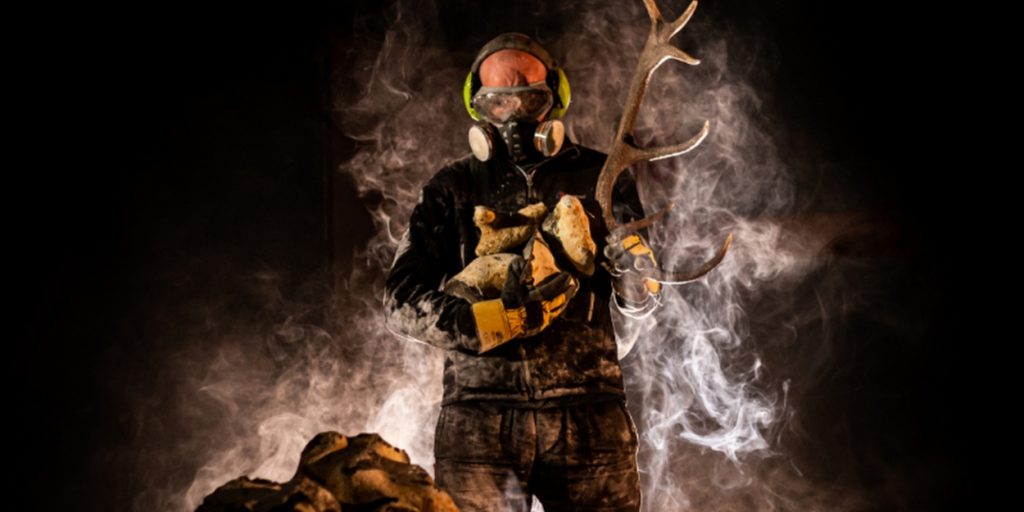
Over at Zoo Southside,Mechanimal’s Megalith promises – and delivers, ‘rocks, beats, geological bodies and stone circles’. A performer and sound artist (accompanied by two technicians also brought into the stage action) ‘playfully duet to deep-time techno, metamorphic soundscapes and the Internet of Things’.
It starts with the onstage team fiddling and doodling with sounds and images, seemingly failing to get the show started. There are recurrent ‘failed to connect’ to the Internet and timed-out warnings. ’We seem to be having some problems here,’ says the sound artist. It’s only later I twig the relevance of this announcement coming from the stage, rather than from a front-of-house person or usher. After 10 or 15 minutes, the auditorium has finally quietened down, as one group of people after another realise that the show is, in fact, already underway.
At the core of Megalith is an exploration of our crucial relationship to rock, and the part mining has played in our evolution. Every piece of technology we own has come from rock. And copper mining has fuelled the growth of human civilisation for the last 10,000 years. The trajectory of mining and technological development, and where we are at now in the 21st century, is explored – but not through a performance-lecture or other polemical info-driven means. Instead, the ideas are explored poetically: through the juxtaposing of visual imagery, with excellent projections / visual design from award-winning Limbic Cinema; through object manipulation (there are some very lovely stone balances created live); through physical action, as the performer moves through the space, in interaction with the stones, exploring the line-into-circle form at the heart of neolithic constructions such as Stonehenge; and through the excellent soundscape that moves easily from lyrical to industrial, employing everything from found sound to Tibetan bowls to hardcore electronics.
There is also an awful lot of noise and mess as each show involves smashing up to 250kg of rocks live on stage. I love every minute – it is so good to see (and hear) a show with a serious scientific and socio-political message at its heart tell its stories through visual, physical and musical means. A truly smashing show!
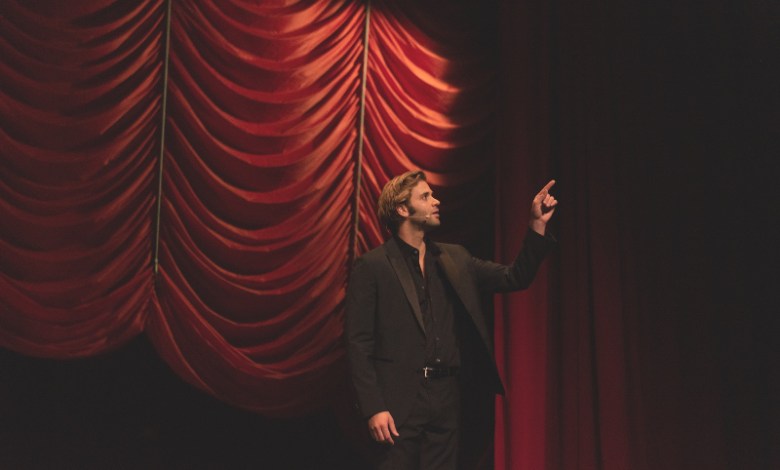
Also at Zoo Southside – following on from Megalith and their stage mess, which must be a bit daunting, are Belgian contemporary theatre makers extraordinaire Ontroerend Goed with Every Word Was Once an Animal. Which is not an object theatre show, it is a show about the nature of theatre, about illusion and reality, about openings and closings. But it is a show in which those most theatrical of material objects – curtains! – play a crucial role, being both the central metaphor of the show, and its key scenographic motif.
The show starts when a person comes on stage, walks to the microphone, and talks. Except it hasn’t started, apparently – it’s about to happen. In just the same way as the Covid pandemic had us stopping and starting, opening and closing, the ensemble of six actors lay out this ‘starting and not-starting’ game until every drop that can has been milked from it. Then, there is the anticipation of the ‘curtain scene’. Lovely swishy red curtains dance, seemingly self-automated, from left to right and right to left, to the strains of Monteverdi. Is this the curtain scene? Apparently not. An actor wheels out a squeaky little trolley bearing a model theatre atop and starts to describe the curtain scene – but no, here comes the curtain scene for real! Later in the show, the luxurious red curtains give away to a plain white tulle which moves aside to reveal a screen. On the screen, images (seemingly still photographs, until we look closely) of views from a series of city or suburban windows (perhaps filmed from the homes of Ontroerend Goed company members or associates during the pandemic?). All is still, all is quiet, There is very little movement. The human world is – inanimate, for the most part. Every Word Was Once an Animal is a visually beautiful show that is a clever exploration on the process of theatre-making and the impact of the pandemic on theatre-makers.
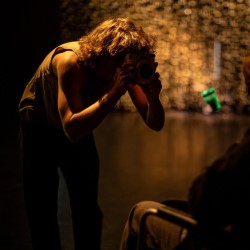
Over at C Venues, Ontroerend Goed have another show. A Smile off Your Face, an immersive one-to-one, was the company’s first big hit at the Edinburgh Fringe back in 2008, winning a Total Theatre Award amongst other accolades. Now they’ve relaunched it in collaboration with the KASK School of Arts (Belgium). Basically, handing over the script to these young people and saying: how would you re-stage it?
It is a piece in which relationship to the material world is also key – although in a very different way to Every Word Was Once an Animal, which has visual scenography as such a crucial element. In A Smile off Your Face, the sense of sight is taken away (for the most part). The audience member is blindfolded and placed in a wheelchair with hands tied. What happens next is a kind of arty ghost train ride. There are footsteps and voices, sounds in the distance and sounds close by. There are things to touch – and things that touch. There are things to taste. There are conversations to be had – with just two crucial visual scenes at the end. To say more would be to spoil the experience. Just to say that that the KASAK students have done a fine job of updating this seminal show, giving it a 2022 twist or two, whilst preserving the essence and authenticity of the original piece. I certainly felt safe in their hands – with just the right amount of occasional edginess.

At Dance Base, Closing Party (arrivederci e grazie) is a dance/physical theatre work in which the relationship between the performers – a pair of fifty-somethings ‘depicting the ups-and-downs of middle age, recasting completion and exhaustion as potential new beginnings’ – is played out through their physical interactions and through the objects they each, and both, engage with. Carnival afro-wigs, a tawdry sparkly headdress, potted plants, wine glasses, a goldfish in a bowl (not a real one!), white feathers, black tutus, not to mention the portable rack all their objects hang from in tote bags… It is all ‘baggage’ that comes with its own baggage. Plus, there are three screens, a large whole-back-wall projection, a TV monitor, and a small tablet played in ‘portrait’ mode on the floor, adding to the visual feast. To the tune of Sylvester’s ‘You Make Me Feel Mighty Real’ and Marianne Faithful’s ‘Broken English’, plus a bit of Ravel and Grieg here and there, the pair – one man, one woman, dressed similarly in plain black suits and shoes – pose and piggy-back, strut and lunge and fireman-lift each other, summoning the spirits of the androgynous hero(ine) Jeanne d’Arc, Jungle Book star Mowgli, and numerous film stars. All is fleeting, all is both meaningful and meaningless. Such is life. And still we party!
Closing Party is produced by Whooshing Machine, the third in the Memory Trilogy of shows created by Alessandro Bernardeschi and Mauro Paccagnella which included the Total Theatre Award-winning Happy Hour, and it is performed by Alessandro Bernardeschi and Carlotta Sagna (with one surprise extra performer).It is a colourful smorgasbord of a show, a constantly shifting landscape of bodies, objects, and moving or still screen images. A feast for the eyes, and a feast for the soul.
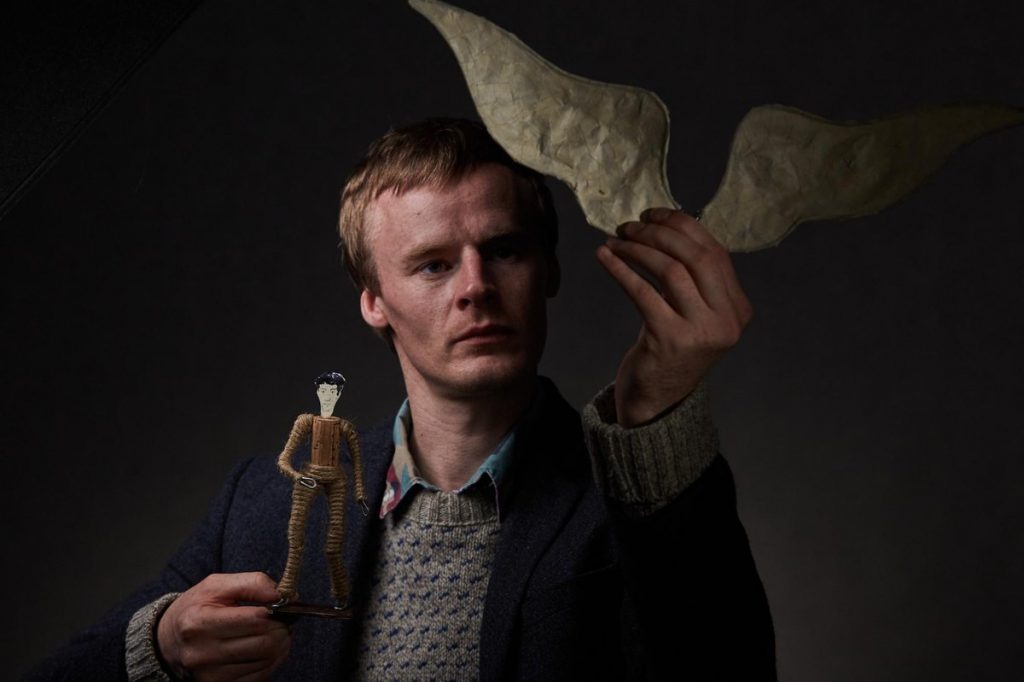
Finally, it’s back to Summerhall for another early morning show – this time, the family-friendly A Very Old Man With Enormous Wings, directed by Irish theatre-maker Dan Colley, and winner of Best Design at Dublin Fringe Festival 2019.
Two performers, one man and one woman, in a theatricalised version of storyteller mode. An old kitchen table, used – yes! – for tabletop puppetry. A screen at the rear of the stage made of vertically cut ribbons of material. A microphone and a looping machine. And a cabinet of curiosities, featuring tiny dolls and bottles and little figures made from paper-cuts and matchboxes and pipe-cleaners and corks.
The Gabriel Garcia Marquez’ short story with ‘no lesson to learn, so don’t you be looking for one’ is told here with feisty good humour and a more-than-able array of theatre skills. And it’s a theatre piece that reminds us constantly that this is a construct: the two constantly nudge each other, finish sentences, and tell each other what comes next, and how it should be played.
Here’s the basic story: one night – after the endless rain has stopped, the crabs have gone back to the sea, and the baby has finally got over his fever – a young couple called Pelayo and Elisenda come across a fallen angel, the eponymous Very Old Man With Enormous Wings, who they put temporarily in their chicken coop, although this decision gets extended as their worry for his well-being turns to downright exploitation as they start charging visitors to gawp and selling mementoes…
All this is told very well by our two performers (Karen McCartney and Manus Halligan) who riff off of each other as they adopt childish personas (that never turn to parody) of the bossy and bragging one, and the shy one who tries hard to please her. Verbal storytelling is enhanced by classic ‘poor theatre’ techniques (a rolled-up jumper becomes the baby), combined with simple puppeteering, the tiny figures on the table growing large onscreen through the use of live-feed video camera. Foley sound effects are looped to give us wind and rain. There are songs, too (from her) and some good word-free acting and object manipulation (from him). Having scattered feathers around the little figure on the table, he then turns the camera on himself and becomes a worryingly anguished old man locked in with the chickens and left to fester.
It’s hard not to be reminded of the classic Kneehigh/Little Angel Theatre puppetry/physical theatre version of A Very Old Man With Enormous Wings – but this more recent take holds its own very nicely. Great to see work made for young people of such high quality.
For show dates and times and further information on all shows, see edfringe.com

